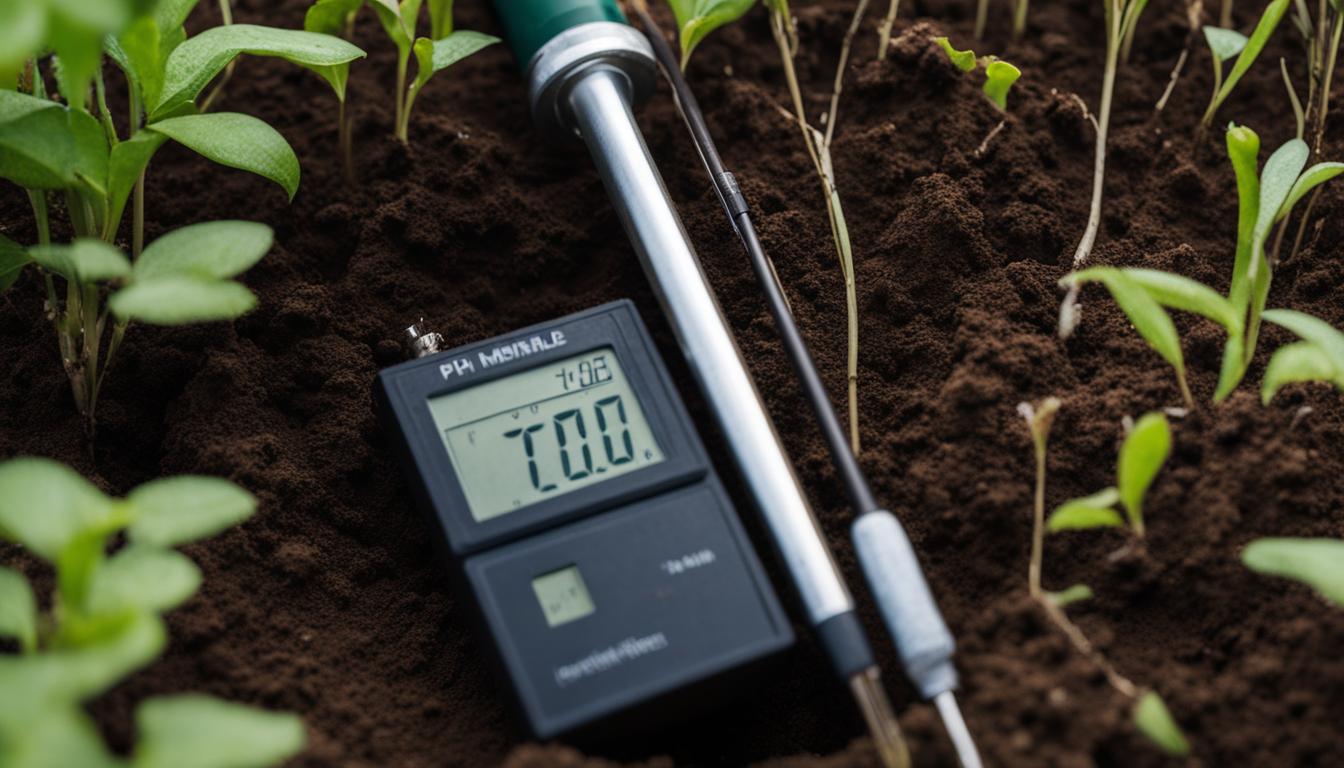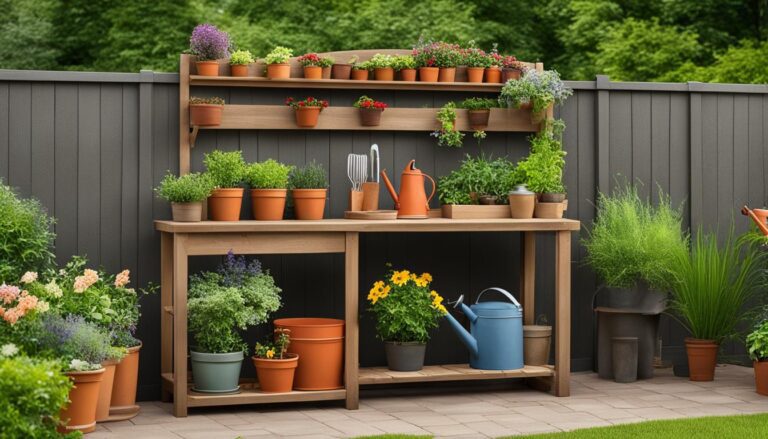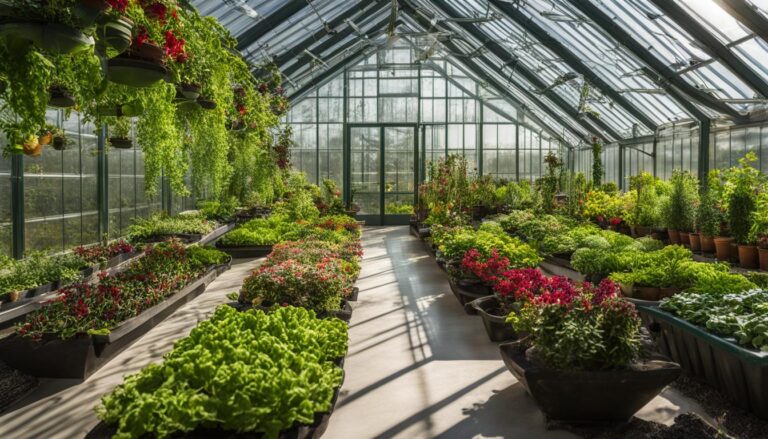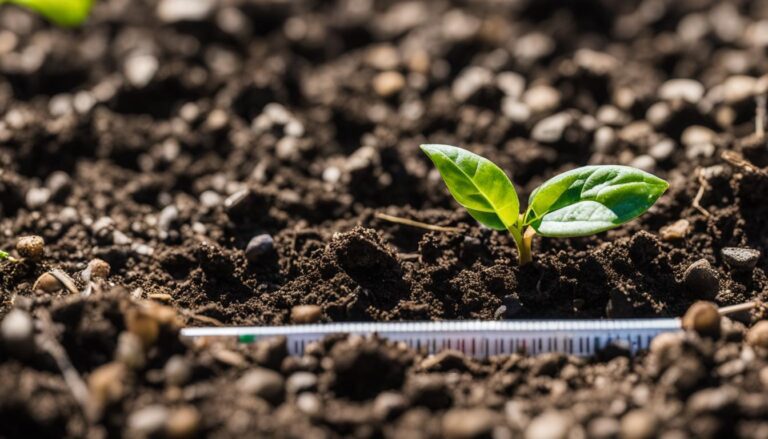
Soil pH meters are essential tools for measuring the acidity or alkalinity of the soil. By understanding how to use a pH meter, gardeners can ensure healthy plant growth by monitoring and adjusting soil pH levels.
pH meters work by measuring the hydrogen ion activity, which is expressed through the potential for hydrogen or ‘pH’.
Key Takeaways:
- Soil pH meters are used to measure the acidity or alkalinity of the soil.
- Measuring soil pH is crucial for ensuring healthy plant growth and nutrient uptake.
- Selecting the right soil pH meter depends on factors such as portability, method of sampling, accuracy, and calibration.
- There are different methods of using a soil pH meter, including direct ground measurement and measurement with a soil solution.
- Understanding soil pH and its impact on plant nutrient availability is key to successful gardening.
What is Soil pH and Why Does It Matter?
Soil pH is a measure of the acidity or alkalinity of the soil. It is expressed on a scale of 0 to 14, with 0 being extremely acidic, 7 being neutral, and 14 being alkaline. Most plants thrive in a soil pH range between 5.5 and 7.5.
Soil pH affects the uptake of key nutrients by plants, and when it is outside the ideal range, nutrient uptake can be hindered, leading to reduced growth potential.
Factors such as weather conditions, fertilizer, irrigation, soil type, and nutrient availability can influence soil pH. Understanding soil pH is essential for maintaining healthy plant growth.
By measuring and monitoring soil pH, gardeners can adjust their cultivation practices to provide the optimal conditions for plant nutrient uptake. This ensures that plants receive the essential nutrients they need to grow and thrive.
The pH Scale and Ideal pH Range
The pH scale ranges from 0 to 14, with each value representing a tenfold difference in acidity or alkalinity. A pH of 7 is considered neutral, while values below 7 indicate acidity and values above 7 indicate alkalinity.
For most plants, the ideal soil pH range is between 5.5 and 7.5. This range provides the optimal conditions for nutrient availability and uptake.
Some plants have specific pH preferences. For example, blueberries prefer acidic soil with a pH between 4.5 and 5.5, while alkaline-loving plants like cacti thrive in soil with a pH between 7 and 8.
| pH Value | Soil Acidity/Alkalinity |
|---|---|
| 0-6.9 | Acidic |
| 7.0 | Neutral |
| 7.1-14 | Alkaline |
It is important to note that extreme pH levels, either highly acidic or highly alkaline, can be detrimental to plant growth. In acidic soil, certain nutrients like calcium, magnesium, and phosphorus may become less available to plants.
Conversely, in alkaline soil, nutrients like iron, manganese, and zinc may become less available. It is crucial to maintain the appropriate soil pH to ensure optimal nutrient uptake and healthy plant growth.
What to Look for When Selecting a Soil pH Meter
When it comes to selecting a soil pH meter, there are several factors that should be taken into consideration. These factors include portability, method of sampling, built-in functions, probe length, accuracy, calibration, sampling time, and device durability.
Each of these factors plays a crucial role in determining the suitability and effectiveness of a soil pH meter for your specific needs.
The first factor to consider is portability. Depending on your requirements, you may need a meter that is designed for field-based use or one that is suitable for lab-based use. This will determine whether you need a handheld meter or a more stationary, desktop model.
The method of sampling is another important consideration. Some meters allow for direct soil sampling, where the electrode is inserted directly into the soil, while others require a soil dilution method, where a soil solution is created for measurement. Select the method that aligns with your testing needs and preferences.
Comparison of Soil pH Meters
| Feature | Portable pH Meter | Lab-Grade pH Meter |
|---|---|---|
| Portability | Highly portable and suitable for field use | Less portable, more suitable for lab use |
| Method of Sampling | Direct soil sampling | Soil dilution method |
| Built-in Functions | Basic pH measurement | Additional functions such as soil moisture and conductivity measurement |
| Probe Length | Varies, can range from a few inches to several feet | Varies, can range from a few inches to several feet |
| Accuracy | Varies, depending on the quality of the meter | High accuracy, suitable for scientific research |
| Calibration | May require calibration before each use | May require less frequent calibration |
| Sampling Time | Quick and efficient | May require more time for sample preparation and analysis |
| Device Durability | Varies, depending on the quality of the meter | Durable and long-lasting |
The accuracy of the meter is another important factor to consider. Look for a meter that offers high accuracy to ensure reliable and precise measurements.
Calibration options should also be taken into account, as some meters require calibration before each use, while others may require less frequent calibration.
Sampling time is a consideration for those who require quick and efficient measurements. Some meters provide instantaneous readings, while others may require more time for sample preparation and analysis.
Lastly, the durability of the meter and electrode is important, ensuring that the device can withstand frequent use and the electrode can withstand various soil conditions.
How to Use a Soil pH Meter for Direct Ground Measurement
To accurately measure soil pH through direct ground measurement, you will need a few essential tools. These include a soil pH meter with an electrode, an auger or shovel, tap water, distilled water, and gloves (recommended for handling soil). The method involves a step-by-step process that ensures accurate results.
Tools Required:
- Soil pH meter with an electrode
- Auger or shovel
- Tap water
- Distilled water
- Gloves (recommended)
Method:
- Dig the soil: Start by digging the soil using an auger or shovel, ensuring there are no rocks or stones that may interfere with the measurement.
- Perforate the soil: Perforate the soil gently using the auger or shovel, creating a hole for the electrode to be inserted.
- Moisten the soil: If the soil is dry, moisten it slightly with distilled water to ensure accurate readings.
- Rinse the electrode: Rinse the electrode of the soil pH meter with tap water to remove any residue.
- Insert the electrode: Carefully insert the electrode into the soil, ensuring it reaches the desired depth for measurement.
- Wait for the reading to settle: Allow the reading on the pH meter to settle and stabilize before recording the measurement.
- Observe the measurement: Take note of the pH measurement displayed on the pH meter, which indicates the acidity or alkalinity of the soil.
- Wash the electrode: Rinse the electrode with distilled water after each measurement to prevent contamination.
- Repeat the procedure: Repeat the entire procedure in multiple locations within the area being tested for a comprehensive analysis.
While direct ground measurement offers the advantage of providing instantaneous results, there are a few negatives to consider. The risk of damaging the electrode is a potential drawback, especially when encountering rocks or other hard objects during the digging process.
Direct ground measurement may provide slightly less accuracy compared to other methods, such as measurement with a soil solution.
Nevertheless, with proper technique and careful handling of the electrode, direct ground measurement can provide valuable insights into the soil pH of your garden or landscape.
| Pros of Direct Ground Measurement | Cons of Direct Ground Measurement |
|---|---|
| Instantaneous results | Potential risk of damaging the electrode |
| Simple and straightforward method | Slightly lower accuracy compared to other methods |
| Allows for on-site testing | Requires careful handling of the electrode |
How to Use a Soil pH Meter for Measurement with a Soil Solution
Measurement with a soil solution is another effective method of using a soil pH meter to determine the acidity or alkalinity of the soil.
This method provides more accurate results compared to direct ground measurement but is slightly more time-consuming. To use a soil pH meter for measurement with a soil solution, you will need the following tools:
- A soil pH meter with an electrode
- An auger or shovel
- Ziplock bags
- Deionized water
- A beaker or cup
- A sieve
- Gloves (recommended)
The method involves collecting soil samples by perforating the soil with an auger or shovel. Once collected, the soil samples are mixed together and sieved to remove any debris. The sieved soil is then weighed, and the appropriate amount of deionized water is measured.
The soil and water are mixed thoroughly and left to settle for a minimum of 5 minutes. After the settling period, the electrode of the soil pH meter is inserted into the soil solution, and the measurement is taken.
Using a soil pH meter for measurement with a soil solution offers several advantages. Firstly, this method provides more accurate results compared to direct ground measurement.
By using a soil solution, you can ensure that the pH measurement represents the overall soil composition instead of just a single point. However, it is important to note that this method is slightly more time-consuming due to the additional steps involved in collecting and preparing the soil samples.
| Advantages | Disadvantages |
|---|---|
| Provides more accurate results | Requires additional time for collecting and preparing soil samples |
| Represents overall soil composition | – |
Overall, using a soil pH meter for measurement with a soil solution is an effective method for determining the pH of the soil. It provides more accurate results and ensures that the pH measurement represents the overall soil composition.
While this method may require additional time for collecting and preparing soil samples, it offers a more comprehensive understanding of the soil’s acidity or alkalinity.
Understanding Soil pH and Plant Nutrient Availability
Soil pH is a critical factor that influences the availability of nutrients to plants. The pH level of the soil directly affects the solubility and accessibility of essential macronutrients and micronutrients.
Different nutrients have varying solubility at different pH levels, and maintaining the optimal soil pH range is vital for healthy plant growth and development.
Macronutrients such as nitrogen (N), phosphorus (P), and potassium (K) play a crucial role in plant growth and are required in large quantities.
These macronutrients tend to be less available to plants when the soil pH is too high or too low, resulting in nutrient deficiencies and stunted growth.
On the other hand, micronutrients like iron (Fe), manganese (Mn), and zinc (Zn) are required in smaller quantities but are equally essential for plant health. These micronutrients are more available to plants at specific pH ranges, and extreme pH levels can lead to nutrient toxicity.
The acidity or alkalinity of the soil affects the chemical reactions that occur in the soil, thereby influencing the release or retention of nutrients. In highly acidic soils, nutrients like calcium (Ca), magnesium (Mg), and phosphorus (P) can become locked up and less available to plants.
Conversely, in alkaline soils, micronutrients like iron (Fe) and zinc (Zn) may become less available due to increased precipitation or formation of insoluble compounds.
By understanding the relationship between soil pH and nutrient availability, gardeners can take proactive measures to optimize the nutrient uptake by their plants. Regular soil testing and monitoring of pH levels are essential for maintaining the ideal pH range for plant growth.
This can be achieved through the use of pH meters, as discussed in previous sections, to accurately measure soil pH and make necessary adjustments. Ensuring the optimal soil pH promotes healthy plant growth and increases the overall success of gardening endeavors.
Factors Influencing Soil pH
Several factors can influence soil pH, ultimately impacting the acidity or alkalinity of the soil. Understanding these factors is crucial for maintaining optimal soil conditions for plant growth. Let’s take a closer look at some of the key factors that can affect soil pH:
1. Parent Material:
The parent material from which the soil forms plays a significant role in determining its pH. Soils formed from materials like sandstone or shale tend to be more acidic, while those derived from limestone are typically more alkaline.
2. Precipitation Levels:
Precipitation levels can also affect soil pH. Areas with high rainfall tend to have more acidic soils, while arid climates often lead to alkaline soils. The amount and frequency of rainfall can influence the leaching of acidic or basic ions from the soil.
3. Plant Growth:
Plants have a direct impact on soil pH through their root exudates. As plants grow, they release hydrogen ions into the soil, which can make it more acidic. The type of plants present in an area can contribute to a shift in soil pH over time.
4. Fertilizer Applications and Irrigation Water Quality:
Fertilizer applications, particularly those containing nitrogen, can affect soil pH. Nitrogen-based fertilizers can acidify the soil over time. Similarly, the quality of irrigation water can also influence soil pH. Water with high calcium and magnesium levels can lead to alkaline conditions.
5. Acid Rain:
Acid rain, which is caused by the release of sulfur dioxide and nitrogen oxides into the atmosphere, can have a significant impact on soil pH. When acidic rainwater infiltrates the soil, it contributes to the acidification of the soil, potentially affecting plant health and nutrient availability.
By considering these factors and their impact on soil pH, gardeners and agricultural professionals can make informed decisions about soil management and take appropriate measures to maintain optimal pH levels for successful plant growth.

Amending Soil pH
Adjusting soil pH is an important aspect of gardening, as it directly affects the availability of nutrients for plants. Whether your soil is too acidic or too alkaline, there are methods to amend the pH and create an optimal growing environment for your plants. Here are some key techniques for amending soil pH:
1. Soil pH Adjustments:
To decrease soil acidity and raise the pH, the addition of liming materials can be effective. One commonly used liming material is calcium carbonate, which helps neutralize soil acidity. On the other hand, if your soil is too alkaline, you can use soil-acidifying products such as peat moss, elemental sulfur, or pine needles to lower the pH.
2. Maintaining Neutral pH:
For those seeking to maintain a neutral pH or make small adjustments, incorporating finished compost high in organic matter can be beneficial. Organic matter acts as a buffer, helping to stabilize pH levels and create an optimal growing environment for plants.
It is important to note that when amending soil pH, it is recommended to test the pH levels regularly to ensure the desired results are achieved. By monitoring and adjusting soil pH, gardeners can create the ideal conditions for healthy plant growth and maximize nutrient uptake.
Liming Materials and Soil-Acidifying Products
| Liming Materials | Soil-Acidifying Products |
|---|---|
| Calcium Carbonate | Peat Moss |
| Dolomitic Lime | Elemental Sulfur |
| Wood Ash | Pine Needles |
Table: Liming materials such as calcium carbonate and dolomitic lime can be used to raise soil pH and decrease acidity, while soil-acidifying products like peat moss, elemental sulfur, and pine needles can help lower the pH and reduce alkalinity. Choose the appropriate amendment based on your soil’s pH requirements.
Testing Soil pH
Regular soil pH testing is essential for maintaining optimal soil conditions and ensuring healthy plant growth. There are two main methods for testing soil pH: professional soil tests conducted by commercial laboratories and DIY testing methods that can provide a general idea of soil pH.
Professional Soil Test
A professional soil test is the most accurate method for determining soil pH. This test provides comprehensive analysis of the soil, including pH levels and nutrient composition.
To conduct a professional soil test, collect a soil sample from different areas of the garden, ensuring to avoid areas with recent fertilizer application.
Remove any debris, rocks, or plant material from the sample. Air dry the soil sample and send it to a commercial laboratory for analysis. The lab will provide a detailed report with recommendations for soil amendment based on the pH levels.
DIY Testing Methods
If you’re looking for a quick and easy way to get a general idea of your soil pH, there are a few DIY testing methods you can try. One method involves using household items like vinegar and baking soda. Collect soil samples from different areas of the garden and divide them into separate containers.
Add vinegar to one container and observe the reaction – if it fizzes, the soil is alkaline. To test for acidity, add baking soda to another container and observe the reaction – if it fizzes, the soil is acidic.
Another DIY method is to use a pH meter, either through direct ground measurement or measurement with a soil solution. Collect a representative soil sample and follow the instructions provided with the pH meter to obtain a reading.
Collecting a Soil Sample
Regardless of the testing method you choose, it is important to collect a representative soil sample. Take samples from different areas of the garden to account for variations in soil pH.
Use a clean stainless steel or plastic trowel to collect soil from a depth of 6-8 inches. Combine the soil samples in a clean container, breaking up any clumps and removing stones, roots, or debris. Mix the soil thoroughly and allow it to air dry before conducting the desired testing method.
Testing soil pH is a crucial step in maintaining healthy soil and ensuring successful gardening. Whether you opt for a professional soil test or try a DIY testing method, understanding the pH levels of your soil will help you make informed decisions about soil amendments and provide the best conditions for your plants to thrive.
The Importance of Soil pH in Gardening
Soil pH is a critical factor in determining the success of gardening endeavors. The pH level of the soil directly impacts healthy plant growth, nutrient uptake, and overall plant performance.
It plays a pivotal role in the availability of essential nutrients to plants. When the soil pH is within the ideal range, typically between 6.0 and 7.5, plants can efficiently absorb the necessary nutrients for optimal growth and development.
Plants rely on a balanced pH level in the soil to access essential macronutrients and micronutrients. If the soil pH deviates from the ideal range, nutrient availability can be compromised.
Soil that is too acidic or too alkaline can limit plants’ ability to absorb nutrients, leading to stunted growth, nutrient deficiencies, and poor overall plant performance.
Gardeners who understand the importance of soil pH and actively monitor and adjust it as needed can greatly enhance their gardening success.
By regularly testing the soil pH using a pH meter or other testing methods, gardeners can ensure that their plants are growing in an environment that promotes optimal nutrient uptake and healthy plant growth.
Maintaining the correct soil pH level is a fundamental practice in gardening that can significantly impact the overall success and vibrancy of a garden.
Soil pH and Nutrient Availability
| Nutrient | Optimal pH Range | Availability at Extreme pH Levels |
|---|---|---|
| Nitrogen | 6.0 – 7.5 | Less available in highly acidic or alkaline soils |
| Phosphorus | 6.0 – 7.5 | Less available in highly acidic or alkaline soils |
| Potassium | 6.0 – 7.5 | Less available in highly acidic or alkaline soils |
| Calcium | 6.0 – 7.5 | More available in acidic soils |
| Magnesium | 6.0 – 7.5 | More available in acidic soils |
The table above shows the optimal pH range for nutrient availability and the effects of extreme pH levels on nutrient accessibility. Maintaining the soil pH within the recommended range ensures that essential nutrients are readily available to plants, promoting healthy growth and maximizing gardening success.
I hope this article has provided you with valuable insights into the importance of soil pH and the usage of a pH meter for soil testing. Maintaining the proper soil pH is crucial for promoting healthy plant growth and maximizing nutrient uptake.
By accurately measuring the acidity or alkalinity of your soil, you can make informed decisions about pH adjustments and create an optimal environment for your plants.
A pH meter is a reliable tool that allows you to monitor and track changes in soil pH over time. Whether you choose direct ground measurement or measurement with a soil solution, a pH meter provides you with real-time results and helps you make precise adjustments to ensure your plants thrive.
Remember that different plants have specific pH requirements, so it’s important to regularly test your soil and make any necessary adjustments accordingly.
By understanding the influence of soil pH on nutrient availability, you can optimize plant performance, prevent nutrient deficiencies or toxicities, and ultimately achieve gardening success.
FAQ
How do I use a pH meter for soil testing?
To use a pH meter for soil testing, you can either directly measure the soil pH by inserting the electrode into the ground or measure a soil solution by mixing soil samples with water and inserting the electrode into the solution. Both methods provide valuable information about soil acidity or alkalinity.
What is soil pH and why does it matter?
Soil pH is a measure of the acidity or alkalinity of the soil. It is important because it affects nutrient availability for plants. Different plants have different pH preferences, and maintaining the appropriate pH level ensures optimal nutrient uptake and healthy plant growth.
What should I look for when selecting a soil pH meter?
When selecting a soil pH meter, consider factors such as portability, method of sampling (direct ground measurement or soil solution), built-in functions (such as moisture and conductivity measurement), probe length, accuracy, calibration options, sampling time, and device durability.
How do I use a soil pH meter for direct ground measurement?
To use a soil pH meter for direct ground measurement, you need the meter with an electrode, an auger or shovel, tap water, distilled water, and gloves (recommended). The method involves digging the soil, moistening it if dry, rinsing the electrode, inserting it into the soil, waiting for the reading to settle, and repeating the procedure in multiple locations for accurate results.
How do I use a soil pH meter for measurement with a soil solution?
To use a soil pH meter for measurement with a soil solution, you need the meter with an electrode, an auger or shovel, ziplock bags, deionized water, a beaker or cup, a sieve, and gloves (recommended). The method involves collecting soil samples, mixing them together, sieving the mixed soil sample, mixing it with deionized water, waiting, and then inserting the electrode into the solution to measure the pH.
How does soil pH affect plant nutrient availability?
Soil pH directly influences nutrient availability for plants. At extreme pH levels, some nutrients become insoluble and unavailable for plant uptake. Acidic soils can lead to aluminum toxicity, while alkaline soils can result in micronutrient toxicity. Maintaining a pH within the appropriate range ensures optimal nutrient availability for healthy plant growth.
What factors influence soil pH?
Several factors influence soil pH, including the parent material, precipitation levels, plant growth, fertilizer applications, irrigation water quality, and acid rain. Different parent materials can result in acidic or alkaline soils, while rainfall and irrigation water can impact soil pH. Plants and fertilizers can also contribute to changes in pH.
How can I amend soil pH?
To amend soil pH, you can add liming materials like calcium carbonate to decrease acidity and raise pH in acidic soils. For alkaline soils, you can use soil-acidifying products such as peat moss, elemental sulfur, or pine needles to increase acidity and lower pH. Adding finished compost high in organic matter can also help maintain a neutral pH or make small pH adjustments.
How do I test soil pH?
You can test soil pH by either sending a soil sample to a commercial laboratory for a professional soil test or using DIY testing methods. DIY methods include using basic kitchen ingredients like vinegar and baking soda or directly measuring soil pH using a pH meter through direct ground measurement or measurement with a soil solution.
Why is soil pH important in gardening?
Soil pH is important in gardening because it directly affects nutrient availability for plants. By maintaining the appropriate pH level, gardeners can ensure optimal nutrient uptake, healthy plant growth, and gardening success.







2 Comments
Comments are closed.